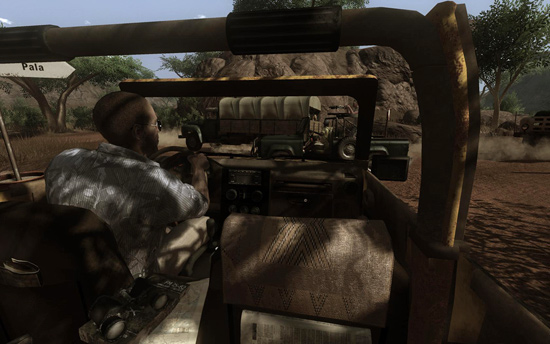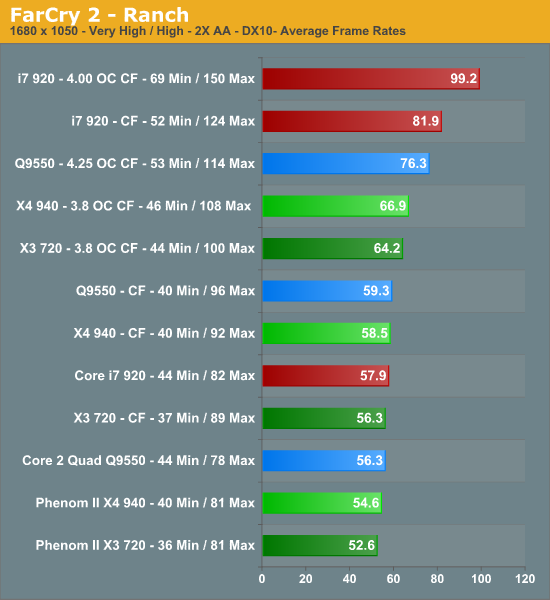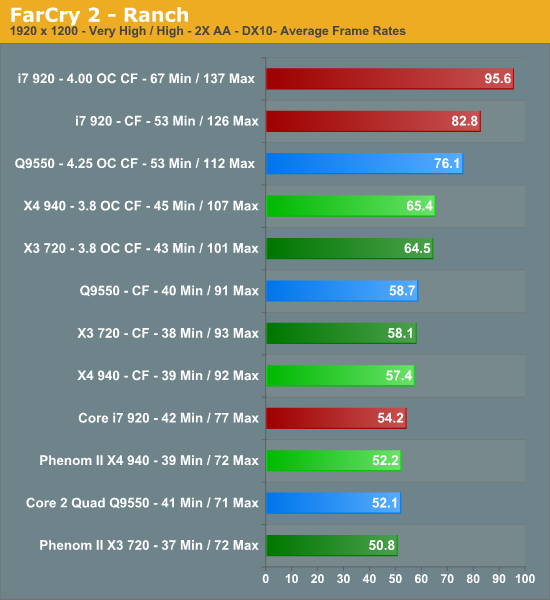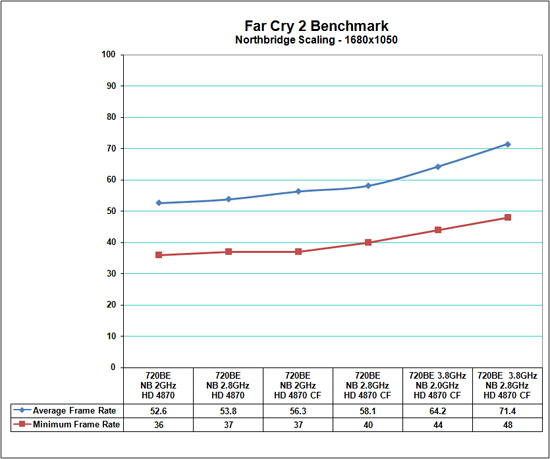Phenom II X3 720BE & CrossFire X Performance - Does it Compete?
by Gary Key on March 28, 2009 12:00 AM EST- Posted in
- Motherboards
FarCry 2

This title has beautiful graphics, an open ended environment, and is fun to play... but traveling between missions tends to get repetitive. If you dial up the graphics options, the game rewards with you some fantastic visuals courtesy of the Dunia Engine. The game also features the most impressive benchmark tool we have seen in a PC game. We set the performance feature set to Very High, graphics to High, and enable DX10 with AA set to 2x. The in-game benchmark tool is utilized with the Ranch Small level and we report an average of three test runs.

Two things still hold true about this game. It favors the Intel processors, and once you provide enough GPU horsepower, the performance of the i7 platform is untouchable. If you wanted to pick a single benchmark and show a large disparity in gaming performance between the Intel and AMD platforms, this is the one to use. Does that mean the game play experience on the Phenom II platform is bad, certainly not, in fact it is very good. However, you can run higher resolutions and/or quality settings on the i7 platform and improve your game play experience without affecting performance.
In the 1680x1050 single card and CrossFire test, the 720BE trails the X940 by 4% on average even with a clock speed disadvantage of 7%. The 720BE does hold an L3 cache per core and Northbridge speed advantage but clock speed is still important in the game. Adding a second card for CrossFire operation improves average frame rates by 7% and minimum frame rates less than 1% for the 720BE. Once we overclock our 720BE, average frame rates increase 14% and minimum frame rates 19% over stock CF numbers.

At 1920x1200, the benchmarks reveal nothing new between the platforms. The Phenom II processors are competitive with a single card configuration with the 720BE only trailing the X4 940 by 3%. As we start to become CPU/GPU limited the 720BE trails the X4 940 by less than a 1% in the CrossFire tests. Adding a second card to the 720BE system for CrossFire operation improves average frame rates by 14% and minimum frame rates by less than 1%. Neither Phenom II competes with the Q9550 in either average or minimum frame rates. The i7 is just stupid fast in these benchmarks compared to the other systems.
When it comes to game play experience and not benchmark tests, all three platforms behaved in a similar manner at our specified settings. We did not notice any advantages with the improved frame rates that the i7 offers over the other two platforms. However, with the i7 we could change the graphic settings to Very High and increase AA to 4x and still experience very good game play. It was as if nothing changed except now we were looking at the savannahs of Africa in a much better way. These same settings were not always a pleasant experience on the other two platforms during heavy action scenes, but the game remained playable for the most part.
Increasing Northbridge Speed for Performance Improvements
One of the quickest ways to extract additional performance on the Phenom II (also Phenom) platform is to increase Northbridge speeds. We are working on a separate article covering the advantages and disadvantages of this setting. Our initial results are positive for applications that heavily depend on memory throughput and low latencies. We thought it would be interesting to see what would occur if the Northbridge speed was raised from a stock 2GHz level to 2.8GHz on our 720BE processor in Far Cry 2. This is worst comparative game title for our AMD Phenom II processors today, so let's see if we have any performance improvements at 1680x1050.

At stock processor speeds with a single video card there is a 2% increase in average and minimum frame rates. We did not expect much as the data pipeline is not under a lot of stress at this point. As we move to our CrossFire X configuration at stock CPU speeds there is a 3% increase in average frame rates and 8% in minimum frame rates. Now it gets interesting as we overclock our CPU to 3.8GHz and are able to feed the data pipelines in a proper manner, at least we thought so. By increasing our NB speed to 2.8GHz, the average frame rates increase 11% and minimum frame rates increase 9%. We have noticed similar results at 1920x1200 in this game and in other applications.
All that required was a simple increase in CPU/NB VID from 1.200V to 1.375V with this particular CPU. Some CPUs will require additional voltage and/or improved cooling to clock up the Northbridge speed to this level. In our experiences to date with the Phenom II processors, all of our samples have hit 2.8GHz with 1.375V to 1.425V on good air-cooling.










59 Comments
View All Comments
marsspirit123 - Sunday, May 31, 2009 - link
For the $160 less with amd 720 you can get 4890 in cf and beat I7 for the same money in thouse games .Royal13 - Saturday, April 11, 2009 - link
Which system will perform better in games? I can not oc mine E6600 more then 3GHz with box cooler, but was hopping for 3.5GHz at least with X3 720. Can it be done without any alternative cooling?GFX does not really metter. I have 9800GX2, 3870X2 and 4870 at the moment.
Or should I just go for PII940 instead? It costs around 100$ more, but a don't have a lot to spend, so CPU should hold 2 years. The same as mine E6600 did.
What do you think?
I want to oc, less power usage, more like a standard internet pc, but with a good gfx, course I have SyncMaster T260HD, so I am forced to run games at 1900x1200.
7Enigma - Tuesday, March 31, 2009 - link
Guys, I love CoH. I'm currently playing OF and will probably be getting the latest expansion in a couple weeks but for the love of God please use DX10!You've used this same introduction for ages now:
"In the meantime, we crank all the options up to their highest settings, enable AA at 2x, and run the game under DX9. The DX10 patch offers some improved visuals but with a premium penalty in frame rates."
That premium penalty is what exactly? 20%? 50%? In this test you have a MINIMUM frame rate of 45 with a single card at the stock cpu frequencies, while the average is >110fps. That's like running at 800X600 resolution so you can have 400fps. I get that at some crazy high resolutions or with very lopsided hardware (fast cpu with slow gpu or vice-versa) you may have some frame rate issues, but please this is a RTS and not a FPS. If you want it to age better and have it actually stress the system properly (regardless of whether it looks tremendously better) use DX10.
All you have to do is change the introduction to say, "In the meantime, we crank all the options up to their highest settings, enable AA at 2x, and run the game under DX10. DX9 offers virtually the same graphical experience minus some improved visuals but at a significantly increased framerate".
Great article btw!
Plyro109 - Tuesday, March 31, 2009 - link
Well, my memory isn't the best sometimes, but if I remember, on my computer going from DX9 to DX10 on CoH resulted in about a 70% performance hit. This equates from about 120FPS to about 30-35 for the average, and on the minimum end, from 35 to about 10.I'd rather have the MUCH higher framerate than the SLIGHTLY improved visuals.
7Enigma - Wednesday, April 1, 2009 - link
So I did a bit of googling and you are correct; seems to be about a 70% performance penalty which is significant. For gaming I agree with you, but for benchmarking I still think DX10 should be used, if only to stress the gpu/system more in line with the other titles used.I didn't realize it was so bad since I'm gaming on a 19" LCD and cranked everything up to max with 4X AA...but I did just build my gaming rig in January with a 4870 so the combination of good hardware and low res is probably what hid the huge drop in framerate.
Niteowler - Monday, March 30, 2009 - link
I had to make the decision between a Phenom 2 quad-core 940 or a Phenom 3 720 triple-core cpu about 3 weeks ago. I went with the 940 because it's a stronger performer across the board and one obvious reason that i figured out that wasn't mentioned in this article.....the cost of each system. Phenom 3 motherboards cost more in general and DDR3 is certainly more expensive. There was only about $10 to $15 difference for both systems. It basically came down to whether I wanted DDR3 or an extra core more. Phenoms don't really take full advantage of DDR3 yet in any of the reviews that I have read. The 720 is a decent performer in it's own right and I wouldn't have felt to bad buying one until the black edition quad core Phenom 3's come out.Visual - Monday, March 30, 2009 - link
What you call "Phenom 3" is more properly "Phenom X3", or triple-core. you make it sound confusingly like third-generation or something.Also, it runs perfectly fine on AM2+ motherboards, with DDR2. You are right that AM3 and DDR3 are more expencive, but that is not related to the CPU choice.
Not that there's anything wrong with going for the quad 940 - I think it is worth the extra cash... just pointing out, it is indeed some extra cash, quite more than the $10-$15 you state, compared to a X3 AM2+ setup.
XiZeL - Sunday, March 29, 2009 - link
grate article... really makes you think twice before spending extra cash on an intel rig.tshen83 - Sunday, March 29, 2009 - link
There used be a time where reviewers would properly review a platform. It is funny to read articles that say "Phenom is a great gaming platform" because the so called "equivalent gaming performance" compared to last-gen Intel core2 based CPU is simply GPU bound, even with crossfire.X3 processors are junk. They are broken POS that AMD couldn't sell unless one core is disabled. The question is why would you want to buy a triple core 95W processor, when you can buy a quad core 75W ACP(95W TDP) Opteron 1352 for about $110 now on newegg. Pay more and get less core :)
I can hardly recommend Phenoms when the Q8200 is a much better performer from a previous generation. Then again, the i7-920 simply trumps anything AMD has right now.
If you are a casual gamer, even Atom 330 on Nvidia 9400M can be a great platform for only 20W total platform power consumption. AMD better pick up their pathetic engineering effort and start doing some thinking, because the time bomb is ticking for them. I actually like Dirk Myers, compared to that POS Hector Ruiz.
waffle911 - Sunday, March 29, 2009 - link
I fail to see a single valid and substantiated argument in your poorly written post, other than the fact that the PII 720BE costs more than the Opty 1352, and has a higher TDP.The X3 is an X4 with one core disabled either because it has a defect or because AMD needed to boost there quota of X3's to meet demand, which is actually becoming the more frequent of the two situations. Your arguments for "energy efficiency", if that is what you're arguing, are comparing apples to oranges. You have performance, or you have efficiency. But overall efficiency is also affected by how much data can be processed for each joule of energy expended, and in that vein the 720 still trumps the 1352, because it can process a certain amount of information faster enough than the 1352 that it can expend less energy overall despite having higher peak energy use. And that 95W rating isn't very indicative of how much energy it will actually use for any given task, either (nor, for that matter, is the 75W rating of the Opteron).
PII 720:
2.8GHz
4000MHz HT
L1 2x128kB
L2 3x512kB
L3 6MB
45nm
$135.99
Opt 1352:
2.1GHz
2000MHz HT
L2 4x512kB
L3 2MB
65nm
$114.99
You are definitely getting less processor for less money. Not only is the Opteron (a server/workstation processor!) using technology that's approaching 2 generations old, but price/performance wise the 720 is a better performer for most desktop applications. Not many (if any) games use 4 cores, so they benefit more from the added speed than the number of cores. Plus, you get an unlocked multiplier and actual room to overclock. For my $20 extra, I would gladly take a 720 clocked at 3.6 or a conservative 3.4 over an Opty 1352 at an optimistic 2.6, if you can get it to overclock at all. It's all about quality over quantity. I would rather have one BMW 335i over 2 Honda Civic Si's if I'm going to be the only one driving them. And it would only be me, because games only use 2 cores at best, not 4, and I can only drive one car at a time. You have 2 cores left over doing nothing, just like I've got one Civic Si sitting parked in my driveway while I drive the other.
And no, the Q8200 is not necessarily a better performer. In most applications, the PII 920 will outperform it (it'll even compete with the Q9300, which is more recent), and now it is priced similarly ($164), making it a much better value. But the PII 720 has longevity on its side, because its compatible with AM3. The Q8200 has nowhere to go, and LGA775 is a dying breed. I like knowing I can upgrade my system in bits and pieces further on down the road as I can afford them, rather than having to fully replace my motherboard, CPU, and RAM all at once. I can do the CPU now, the motherboard and RAM later when prices come down, and then when a better high-end CPU comes along I can upgrade to that as well.
Plus, while the i7-920 may beat anything AMD has right now, it's a terrible value for the money. Between an $800 PII 720 gaming rig and an $800 i7-920 gaming rig, the 720 allows room in the budget for better graphics, more RAM, more HD space... the i7 just doesn't allow for a very balanced system on a budget.
And I have yet to see a single commercially available example of an Atom paired with a 9400M. All of the ones out there are engineering/testing samples. But when that does come along, I will gladly get it and put it in my car PC.